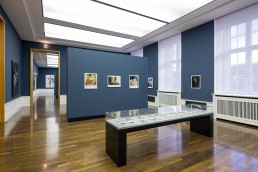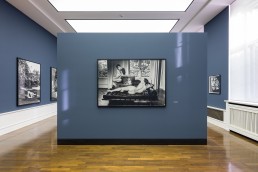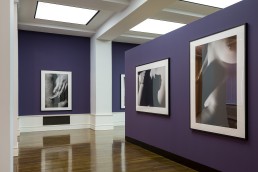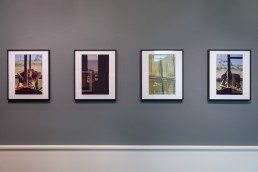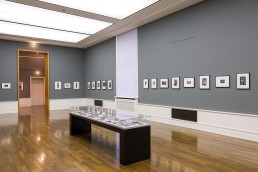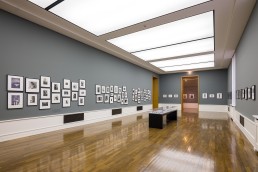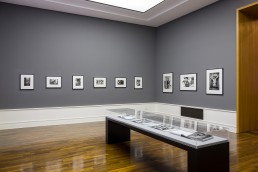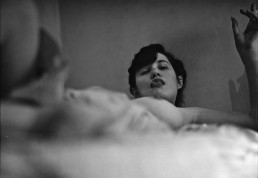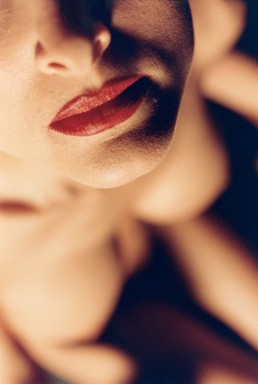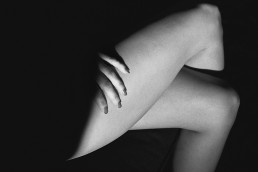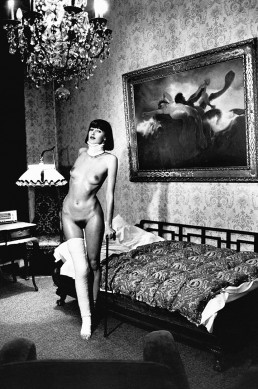Saul Leiter, David Lynch, Helmut Newton: NUDES marks the first time in the history of the Helmut Newton Foundation that an exhibition will be dedicated exclusively to the genre of nude photography.
Saul Leiter, parallel to his fashion photography for Harper’s Bazaar and the colorful abstractions he captured on the streets of New York from the 1950s onwards, also photographed nudes in the studio. His female models were friends or lovers, whom the artist portrayed in his New York apartment; not all of them are entirely undressed. The images are subtle, sensitive, almost shy approaches to the female body and spirit.
We encounter a similar visual atmosphere in the nudes of David Lynch, taken almost half a century later mostly in Lodz and Los Angeles. Many of them are in black and white; a few are in color. In his abstract images, details often fill the frame; only upon closer examination can we associate them with the human body and compare them to our own in our mind’s eye. His photographic nudes, sometimes more observational, sometimes more posed, are as enigmatic as his films.
Helmut Newton began photographing nudes in the 1970s, both independently and incorporated into his fashion photography, and worked in this genre until the end of his life in 2004. His series Naked and Dressed, which marks the transition from fashion to nudes in his work, and his Big Nudes made him world-famous in the 1980s and inspired countless photographers and other visual artists to imitate or re-interpret them. Newton created an incomparable body of work, full of subtle seduction and timeless elegance, especially in the nude genre.
Selected Works
Nudes
Matthias Harder
The new three-part exhibition, Nudes, is the first presentation in the history of the Helmut Newton Foundation in Berlin dedicated exclusively to the genre of nude photography. The naked body has been a theme in art since the famous Venus of Willendorf, which was crafted around 30,000 years ago by an unknown artist. Nudes also featured in the pioneering years of photography, the oldest of the new media, as early as 1839. Since then, a special combination of exhibitionism and voyeurism has evolved before the lens of thousands of photographers – more realistic at times, more staged at others. The three photographers presented in the exhibition count among the most empathetic and influential nude photographers of the late 20th century.
Saul Leiter (1923–2013), parallel to his fashion photography for Harper’s Bazaar and the colorful abstractions he captured on the streets of New York from the late 1940s onwards, also photographed nudes in the studio. These quiet, intimate black-and-white photographs, which Leiter developed himself in his darkroom, were kept under lock and key during his lifetime; only a few friends knew them. His female models were friends or lovers whom the artist portrayed in the everyday setting of his New York apartment; they were not professional nude models. As if in an act of conspiracy, they joined the photographer in playful collaboration to challenge the dualistic principle of voyeurism and exhibitionism.
Following Leiter’s death in 2013, his multifaceted artistic legacy has been re-examined and more widely published on the initiative of Margit Erb, director of the Saul Leiter Foundation. In spring 2018, In My Room, a book featuring Leiter’s nudes, was published by Steidl; in summer of 2018, Howard Greenberg Gallery in New York showed a new selection of his nudes. Now this autumn, the Helmut Newton Foundation is showcasing for the first time more than 200 vintage and late prints of Leiter’s nude work, which until recently was relatively unknown.
While about half of the selection on display is framed and on the wall, the other half is presented in an exhibition vitrine as snippets, fragmented by Leiter himself. These tiny gelatin silver prints, with their jagged edges and amorphous shapes, are almost like a second exhibition in miniature. Also on display is a ten-part series of timeless color shots of a half-nude young woman on the terrace of a house by the sea, taken in 1958 in Lanesville, Massachusetts, as well as 15 of Leiter’s hand-colored, black-and-white prints in various formats, which reflect his intensive relationship with the medium of painting. In this part of the exhibition, we encounter small-format nude portraits depicting one or more women as they recline on sofas, become silhouettes against the light, seem lost in thought with a cigarette in hand, casually dress or undress, and pose for Leiter’s camera with a smile or seduction. Not all of the women are naked, but surprisingly this hardly makes a difference. They all reflect the photographer’s subtle, sensitive, almost shy approach to the female body and spirit.
In the nudes by David Lynch (*1946) we might encounter a visual atmosphere similar to that in Leiter’s works. Taken half a century later mostly in Lodz and Los Angeles, they were first published in book form by Fondation Cartier in Paris in 2017, under the title Nudes. These are abstract images of the body, in which details can fill the entire frame, mostly in black and white, a few in color, and only upon closer examination can we associate them with the human body. Lynch decided during the working process to shoot from unexpected perspectives and establish strong contrasts between light and shadow. He also chose a large presentation format, enabling most of his female models to appear larger than life; these 25 motifs were selected and printed exclusively and for the first time for this exhibition in Berlin. The images were created both parallel to and independently of Lynch’s cinematic work, which sometimes contains sexual allusions and actions. His photographic nudes, be they more observational or posed, are as enigmatic as his films. In viewing these images, we sense a tender, tentative exploration of the female body with the camera; such visions are likely only possible through the medium of photography. A sense of intimacy – or the illusion thereof – is achieved through extreme close-ups with an almost tactile physicality, even if only a bare thigh or arm is visible in the frame. In contrast to the women in Leiter’s photographs, Lynch’s nameless models are hired professionals, who take their poses in an indefinable pictorial space. Although one model can be seen lounging seductively on a sofa, here too, the surrounding interior is blurred and undefined, and her face obscured by a cloud of smoke.
Helmut Newton, in contrast to Lynch, often clearly depicted the locations in his fashion and nude photographs, with settings as stylized as his models – be it a panoramic view of the city of Paris, the long staircase in his Parisian studio apartment, or a room at the notorious Pension Florian in Berlin. Newton began photographing nudes in the 1970s, both independently and incorporated into his fashion photography, and regularly worked in this genre until his death in 2004. His series Naked and Dressed, which marks the transition from fashion to nudes in his work, and his Big Nudes made him world-famous, inspiring countless photographers and other visual artists to imitate or re-interpret them. Newton worked until the end of his life to create an oeuvre that is both unparalleled and enigmatic, full of subtle seduction and timeless elegance – especially with his nudes, where he challenged or disregarded many common taboos. Different from Leiter’s nudes, Newton’s nude work was published throughout his lifetime, commissioned in part by magazines such as Playboy or Oui. Newton also succeeded in having some of his independent work printed in fashion and lifestyle magazines. This new presentation brings together more than 80 of his iconic nudes from well-known exhibitions and projects, such as Helmut Newton’s Illustrated: Pictures from an Exhibition, White Women, Sleepless Nights, Big Nudes, Sex and Landscapes, Work, and Us and Them as well as approximately 30 images from the archive of the Helmut Newton Foundation that have not been previously exhibited, including numerous original Polaroids. Among these diverse motifs we see nudes at swimming pools, ingenious shots of unclothed mannequins and other fashion-focused nudes, half-dressed models wearing orthopedic prostheses, and provocative stagings of sexual obsession by a female cast. Together, these images open up a realm of associations where our imagination can wander.

